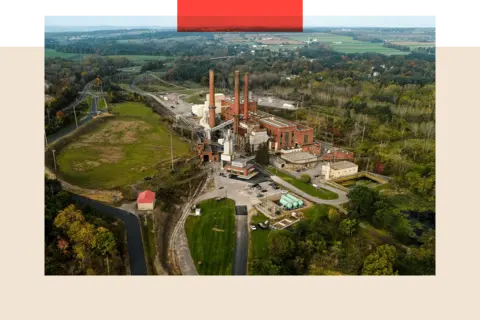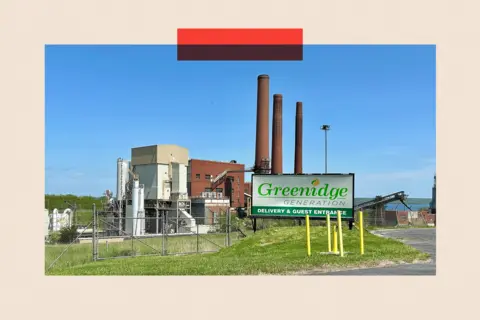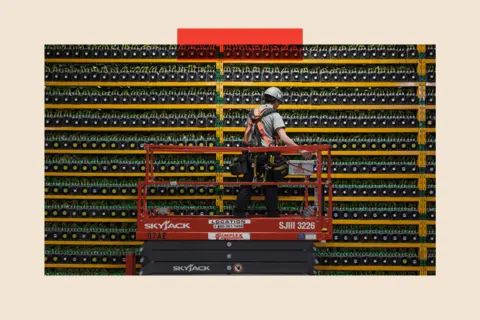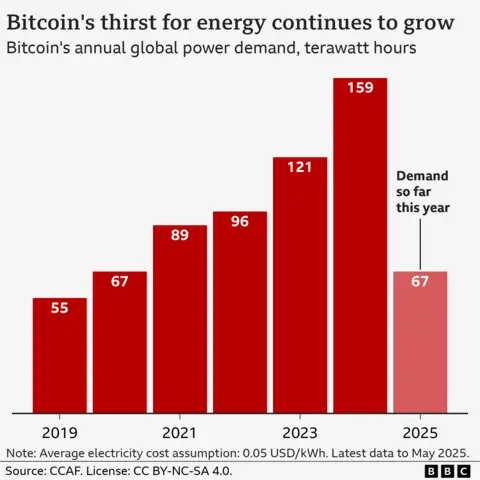

Mike Wendling
Reporting fromDresden, New York

 BBC
BBC
For the last five years, a loud hum has been a continual backdrop to birdsong and the occasional barking dog in the village of Dresden, New York state.
Coming from the nearby Greenidge Generation power plant, which had been mothballed for years before, the sound has angered some local people.
“It’s an annoyance,” says Ellen Campbell, who owns a house on Seneca Lake a short distance away. “If I sit out by the lake, I would rather not hear that.
“We didn’t sign up for the constant hum.”
The issue here in Dresden, a village of about 300 people surrounded by winding country roads, single-track rail lines and farms growing grapes and hops, sounds like a familiar story about the tension between nature-loving locals and economic development.
But their annoyance is also a signal of something less expected – policies of US President Donald Trump meeting resistance from people in the rural areas whose votes drove his return to the White House.
And the cause? Bitcoin mining.
An energy-intensive process that relies on powerful computers to create and protect the cryptocurrency, Bitcoin mining has grown rapidly in the country over recent years. The current administration, unlike Joe Biden’s, is intent on encouraging the industry.
Trump has said he wants to turn the US into the crypto-mining capital of the world, announcing in June 2024 that “we want all the remaining Bitcoin to be made in the USA”. This has implications for rural communities throughout the US – many of whom voted for Trump.

 Associated Press
Associated Press
Installations like the one at the power plant near Dresden are appearing across the country, drawn by record-high cryptocurrency prices and cheap and abundant energy to power the computers that do the mining. There are at least 137 Bitcoin mines in the US across 21 states, and reports indicate there are many more planned. According to estimates by the US Energy Information Administration (EIA), Bitcoin mining uses up to 2.3% of the nation’s grid.
The high energy use and its wider environmental impact is certainly causing some concern in Dresden.
But it’s the unmistakable hum that is the soundtrack for discontent in many places with Bitcoin mines – produced by the fans used to cool the computers, it can range from a mechanical whirr to a deafening din.


“We can hear a constant buzzing,” says another Dresden resident, Lori Fishline. “It’s a constant, loud humming noise that you just can’t ignore. It was never present before and has definitely affected the peaceful atmosphere of our bay.”
Such is Ms Campbell’s annoyance with Trump’s Bitcoin backing, her political allegiance to the Republicans is being tested. “Right now I’m not real happy about that party,” she says.
Backlash in Trump’s backyard
The conflict in Seneca Lake is being played out nationwide, which could pose problems for a White House intent on pursuing a pro-cryptocurrency agenda.
A little over 300 miles west of Dresden, a backlash in the US border town of Niagara Falls prompted the local Mayor Robert Restaino – a Democrat – to issue a moratorium on new mining activity in December 2021, and the following year noise limits of 40 to 50 decibels near residential areas were imposed. He said: “The noise pollution of this industry is like nothing else.”
Locals described the sound as similar to that of a 747 jet, or as grating as having a toothache 24 hours a day, claiming that the noise drowned out the sound of the nearby waterfalls.
And in Granbury, Texas, a 24ft-high sound barrier was erected in 2023 at a mining site after residents complained to public officials that the nonstop roar was keeping them awake and giving them migraines.
All these Bitcoin operations opened before Trump’s return to the White House. But the opposition they have generated suggests public officials in Republican-voting areas are likely to find themselves coming under continued pressure from local people who oppose further Bitcoin mining expansion.
If this happens, could Trump’s crypto dreams be derailed in his own backyard?
Trump’s crypto U-turn
Less than four years ago, Trump said Bitcoin “just seems like a scam”. Yet those reservations have now gone: the Trump family has since started the crypto firm World Liberty Financial, and Trump launched his own cryptocurrency, $TRUMP – 220 of its top buyers were invited to a private gala dinner with the president on Thursday.

 SOPA Images via Getty
SOPA Images via Getty
Trump’s sons Eric and Donald Jr are behind a crypto mining venture called American Bitcoin, which plans to trade on the Nasdaq stock exchange, and aims to build one of the world’s largest and most efficient Bitcoin mining platforms, rooted in American soil.
Bitcoin mining has boomed in the US partly because of a crackdown in China in 2021, which was due to concerns over its environmental damage. Alexander Neumueller, an expert at the University of Cambridge’s Centre for Alternative Finance, says that although it’s hard to trace every last mine, it’s clear that the US is now the leading Bitcoin producer, mining about 40% of the world’s supply.
From village halls to state legal battles
Dresden is in New York’s Finger Lakes region – a rural area sliced through with deep glacial lakes, which attracts tourists drawn by its wineries, breweries and outdoor pursuits. In Yates County, home to Dresden and the Greenidge plant, around 60% of voters picked Trump last November.
According to the owners of the mine, Greenidge Generation, anywhere from 40 to 120 Bitcoin a month are being produced at the plant, along with some energy that flows back to the grid.


The company – which turned down requests for an interview – has argued that they converted a coal-burning operation into a relatively cleaner gas-fired power installation that complies with state environmental laws.
But amid public concern, New York state and Greenidge are currently engaged in a protracted legal battle over the plant’s future. With some of the strictest environmental laws in the country, New York officials are challenging whether the gas-fired plant is permitted under the regulations that allowed the old coal plant. Power generation – and Bitcoin mining – has been allowed to continue during appeal proceedings.
Abi Buddington, who owns a house in Dresden and has been at the forefront of the fight against the crypto mine, says it has become a big issue locally.
“The climate changed, both environmentally as well as in our quiet little community,” she says, recalling raised voices at contentious town hall meetings.


Ms Buddington is trying to change minds in Dresden and, through her network, elsewhere around the country.
“There are some who are environmentally concerned, and who may be Republican-leaning,” she says. “What we’ve found nationally is even in red states, once elected officials are educated properly and know the harms, they are very opposed.”
But not all are convinced. “They’ve been a good corporate neighbour,” says Dresden’s recently elected mayor, Brian Flynn, about the mine. “I’m pro-business, whether it be Greenidge or local agriculture… I think it’s important to have a mix of both industry and recreation.”
Real-world impacts of crypto
Legal battles like the one in Seneca Lake are bringing home the realities of an industry that at first glance might seem contained to banks of data servers, removed from the real world.
Bitcoin “miners” – who are not actually extracting anything from the earth – verify transactions by solving extremely difficult cryptographic problems that require powerful computers. In return, they are rewarded with Bitcoin.

 LARS HAGBERG/AFP via Getty
LARS HAGBERG/AFP via Getty
As the price of Bitcoin has shot up to its current value of around $100,000 (£75,000), ever-increasing amounts of computing power have been needed to win crypto rewards, shutting out smaller miners in favour of large collectives and companies.
As well as the hum, mining’s energy use has environmental impacts. A Harvard study published in March in the peer-reviewed science journal Nature Communications found that Bitcoin mining exposes millions of Americans to harmful air pollution each year – and that 34 Bitcoin mines consumed a third more electricity than the city of LA. (There was some pushback from the crypto industry to the study, which was called The environmental burden of the United States’ Bitcoin mining boom.)
According to the Cambridge Bitcoin Electricity Consumption Index, mining globally uses approximately 0.7% of global electricity consumption.


That has a knock-on effect on local energy prices, which is also provoking a backlash in some areas.
In 2017, Bitcoin miners flooded into Plattsburgh, New York – a city of about 20,000 people a couple of hours to the north of Dresden – because of cheap hydroelectricity rates. “We were getting Bitcoin applications from operators all around the world,” says the city’s mayor at the time, Colin Read.
Yet they used so much power that electricity rates shot up. Within a year, some residents were paying up to 40% more during winter months, Read says.
The following year, he and other local lawmakers passed rules against buildings blasting out hot air.
“Fortunately we put a stop to it,” he says, noting that all but one Bitcoin mining operation left the city.
Opposition in Maga heartlands
Resistance to Bitcoin mines extends to places with the biggest Trump support.
Cyndie Roberson was retired and unaware of the crypto industry until a Bitcoin mining operation moved to her small town in North Carolina in 2021. The locals banded together and managed to ban new Bitcoin developments in their area – but the existing one was allowed to stay and the bitterness of the fight made her decide to move south, to Gilmer County in Georgia.
There, Ms Roberson has campaigned against crypto mining in a region that is solidly pro-Republican. In the county where she lives, she says that around 1,000 people came to a public meeting to oppose a mine, which then wasn’t allowed to operate.
Just north of Gilmer, the Fannin County Commission has enacted a ban on crypto mining, while a Georgian commission representing 18 primarily rural counties has published advice on how to restrict the development of Bitcoin mines.
“When you’re in my backyard, when you’re in my town, trying to wreck our property and our peace, people will tell you, it’s a hard ‘no’,” says Ms Roberson.
Although 80% of local people backed Trump last November, that support doesn’t appear to stop people opposing one of his key crypto goals.
‘You can build your own power plant’
The Trump administration is not planning to do away with all regulations around crypto mining – but it is ready to actively help companies open power plants next to the mines.
In an interview with Bitcoin Magazine in April, commerce secretary Howard Lutnick said: “We’re going to make it so that if you want to mine Bitcoin, and you find the right place to do it, you can build your own power plant next to it,” going on to argue that such projects would stop “these stories about ‘You’re taking too much power and now the cost of operating my refrigerator is higher’.”


“The next generation of miners in America will be able to control their destiny, control the cost of power, and I think that is going to turbocharge Bitcoin mining in America,” Lutnick told the magazine.
According to Zack Shapiro, head of policy at the Bitcoin Policy Institute, a US think tank that researches emerging monetary networks, that process has already begun. “There are states that are passing laws specifically prohibiting municipalities from banning Bitcoin mines,” he says. “It’s a mechanism by which mining companies can fight back.”
And the nature of Bitcoin mining means that, if it meets resistance, it can quickly move on to somewhere more favourable.
When Colin Read tackled the mines in Plattsburgh, he saw how easily they could change location.
“This industry is really footloose,” he said. “When we told these companies they couldn’t have more power without going through hoops, they packed up and went to a community where they didn’t have such strict requirements.”
Offshore mines of the future?
Local opposition is not Trump’s only challenge. Could the sea, for example, be a better location for Bitcoin mining?
Mr Shapiro believes that, with miners looking for the lowest cost, they could turn to leftover renewable energy that can’t be used by other applications. “Wind power in the ocean can’t be used to power a city, but you can set up an offshore platform that captures offshore wind and tidal energy, and use that to mine Bitcoin – because there’s not another buyer to use that energy, it’s probably ultimately where Bitcoin mining operations move.”
It could also be that in the cryptocurrency race, Bitcoin might not be the best bet. Read – who is an energy economist – is sceptical about the staying power of energy-intensive Bitcoin because he believes other more efficient alternatives are going to emerge.
With the White House egging on the industry, fights over Bitcoin mining will inevitably play out in smaller forums, in state and local governments and tiny places like Dresden.
But one constant in the short history of Bitcoin has been volatility. It might be boom times now – yet a downturn in the price, shifts in energy sources and changing crypto needs could fundamentally reshape the Bitcoin mining landscape, no matter how much Trump wants to keep it in the US.
Top picture credit: Getty Images
BBC InDepth is the new home on the website and app for the best analysis and expertise from our top journalists. Under a distinctive new brand, we’ll bring you fresh perspectives that challenge assumptions, and deep reporting on the biggest issues to help you make sense of a complex world. And we’ll be showcasing thought-provoking content from across BBC Sounds and iPlayer too. We’re starting small but thinking big, and we want to know what you think – you can send us your feedback by clicking on the button below.







